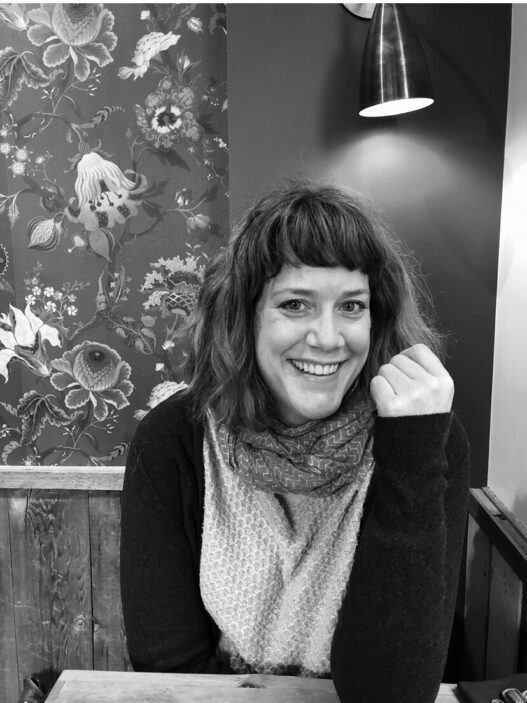Interview by AXO | Originally published in She Zine, 2016 – Expanded for 2025
Before Instagram turned protest into a lifestyle aesthetic and Etsy became a place to sell your rage cross-stitched in cursive, there was Betsy Greer. A writer, sociologist, and longtime thread-wielder, Greer coined the term craftivism (sort of) in the early 2000s, giving language to something many of us were already doing in living rooms, on subway rides, and in the back corners of punk shows: using our hands to push back. Long before brands figured out how to co-opt the politics of handmade, Greer reoriented her crafting community toward a deeper meaning and reminded us that crafting could be an act of defiance—not just decoration. That a stitch could carry protest. That a handmade piece could pull at the seams of the status quo.
We talked to Betsy about the origins of craftivism, how care work shows up in creative spaces, and why making something slowly, intentionally, and imperfectly is still a radical act. If you’ve ever stitched a message between the lines, glued glitter to your grief, or made art as a way of refusing the world as it is—this one’s for you.
Here’s my interview with the Godmother of Craftivism, Betsy Greer, from 2018 – edited for clarity and length
SZ: So here’s the question that everyone wants to know: Who founded the “craftivism movement”? Who’s the creative brain who actually coined the term “craftivism”?
BG: Me. And not me.
I started thinking about the connections between craft and activism in 2002 as part of a research proposal. I was talking about it to my knitting group and one of them said, “you could call it craftivism.” I went home and Googled it and there were four hits, as the Church of Craft had done a craftivism workshop. Since my background is in social science, I liked the idea of putting a new idea online and seeing organically find people. It has grown since then. So while I didn’t coin the term, I helped popularize it. It was just me and a crazy idea that people to like for awhile and then people started calling themselves craftivists, which blew my mind and still does a little bit. It was just a little stupid idea I had one time, and, wait, what? People agree with me? Crazy!
SZ: Can you describe for us the scene when you first became in craftivism?
BG: Craft was becoming more popular in the US at the time and just beginning to become popular in the UK. In 2003 I began writing about it online and moved to London for graduate school that fall. It was a time when people said things tome like one professor who said to me, “You’re writing your dissertation about knitting? I thought you’d be writing about an underground tattoo shop or something.” Well, at the time, knitting was actually pretty weird and new to be done by people under 40 en masse and in public, which we all thought was pretty hilarious (as well as ridiculous).
SZ: In what ways have you been involved in craftivism throughout your life and career?
BG: I’ve been lucky enough to have the opportunity to give lectures about it in North America and Europe and to share it with an international audience through blog posts, essays, articles and books. Sometimes I’ve been paid, sometimes I haven’t. The idea of letting people know that their craft was empowering was and still is important for me to get across.
SZ: So craftivism as a concept exactly new. What craftivists throughout history have influenced your craft?

BG: The Arpilleristas, the Madres de la Plaza de Mayo, Gandhi’s efforts with khaki, Hannah Ryggen, Faith Gillespie. Although anyone that shared and grew their voice through craft counts.

SZ: We obviously know that you’ve written books on craftivism. I, personally, own all of your books. Who is your favourite craftivist author, other than yourself? What is your favourite book on craftivism?
BG: Um, there are like five of us in this category. So I’m going to suggest people to check out books by Sarah Corbett, Rayna Fahey, and an upcoming book by Sayraphim Lothian (full disclosure I wrote the forward). Extra credit, the work of Rachael Matthews and Leanne Prain and the books Woman and Craft and The Subversive Stitch.
SZ: What is the most amazing act of craftivism that you have been involved in? I’m so excited to hear your answer?
BG: I like participating in Chi Nguyen’s 5.4 Million Women and Counting. It had all the hallmarks of a successful collaborative effort: an easy entry point, clear instructions, easy to find materials, a hashtags to follow along and an end date for when the project would be shown.
SZ: And what is the most amazing, inspiring, empowering act of craftivism that you’ve seen in history?

BG: That the Madres de la Plaza
de Mayo are still demanding they know what happened to their loved lone with their headscarves 40+ years later. Amazing.
SZ: What is your opinion of modern craftivists and more recent adopters of adopters of craftivism? And some of the more recent projects?
BG: If you take “modern craftivism” to be from 2003, I’d say that it’s empowering, but that it’s also about finding your voice, which can encompass a lot of different types of work than what is currently found under #craftivism on Instagram.
SZ: Who are the modern craftivists who are really inspiring you right now? Like, who would you say is really making positive change through craft at the moment?
BG: That depends on what you mean by “positive change,” as there is no common metric as to what that means. Apart from the women I mentioned, Shannon Downey is doing great work as well. There are others, but then you come under who wants to be called a “craftivist,” there are scores of people doing political and activist work that is amazing that call themselves all sorts of things.
SZ: Where would you like to see the modern craftivist movement go? In what areas does the world craftivism?
BG: Using craft and creativity to empower yourself and others is needed everywhere, and what that looks like depends on culture and ease of material access. People can use the same concepts to become empowered by nutrition, farming, sports, hobbies, etc., too.
SZ: Is there words of feminist advice or wisdom that you would like to end on? Either your own, or other’s?
Never think that you can’t do something powerful with something that seems like just a stupid idea.
Talking to Betsy in 2018 felt a bit like time travel. We came up in the same internet era — that early 2000s DIY heyday where Typepad and LiveJournal, craftivist blogs, and scrappy web rings were where we lived online, and makers and maker-preneurs were finally claiming a seat at the cultural table. Back then, I was one of countless people quietly fangirling over Betsy’s work from behind a cluttered desk, knitting while I “surfed the web.” She wasn’t just part of the scene — she helped define it. Pretty cool.
All these years later, she’s still shaping the way we talk about craft, care, and community. Betsy’s work continues to remind me (and so many of us) that creativity isn’t frivolous — it’s resistance, resilience, and connection. Whether you’re sewing a protest banner or stitching just to stay soft in a hard world, her voice has always made it feel a little less lonely. Total icon status: confirmed.
In 2025, craftivism seems to be having a global resurgence — and it’s not hard to understand why. Maybe it’s because everything’s going to shit basically everywhere, or maybe people are just desperate to unplug, slow down, and actually feel something. Whatever the reason, more and more people are turning to craft as a way to express deeper truths about the world — not in statements, but in stitches. Words matter, always. But sometimes, craft matters more.

What are the craftivist projects that you think need to be seen?Post pics or links in the comments!
Want to keep building the resistance?
→ Subscribe to our newsletter for creative tools, DIY guides, and subversive skill-building.
→ Tag your projects with #newgirlarmy
→ Or pitch your story to She Zine Mag.
Click the links to buy Betsy Greer's Books!
#NotAffilitates

AXO (she/her) is a multidisciplinary creator, editor, and builder of feminist media ecosystems based in Toronto. She is the founder of She Zine Mag, Side Project Distro, BBLGM Club, and several other projects under the AXO&Co umbrella — each rooted in DIY culture, creative rebellion, and community care. Her work explores the intersection of craft, technology, and consciousness, with an emphasis on handmade ethics, neurodivergent creativity, and the politics of making. She is an advocate for accessible creativity and the power of small-scale cultural production to spark social change. Her practice merges punk, print, and digital media while refusing to separate the emotional from the practical. Above all, her work invites others to build creative lives that are thoughtful, defiant, and deeply handmade.




























